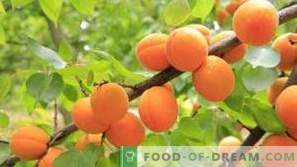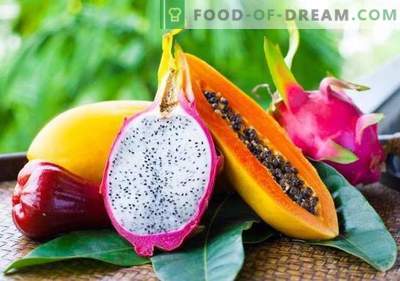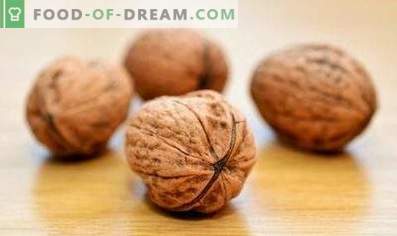
Mandarin - an evergreen plant of the genus Citrus family Rutace. In Latin, its trees and fruits are called C? Trus reticul? Ta, and the usual name "Mandarin" is associated with the properties of soft rind and is derived from the Spanish phrase "se mondar", which translates as "easy to clean."
The mandarin tree, as a rule, reaches a height of 3, 5 meters, but at the age of about three decades it can grow to 5 meters and produce up to 6-7 thousand fruits. Mandarins themselves usually have a radius of 2-3 cm and are slightly flattened along the vertical axis. The difference from other citrus fruits is that the thin rind of these fruits is easily separated from the pulp (sometimes there is even an additional layer of air under its surface). The internal structure of mandarins close to the structure of the fruit of lemon, orange, orange and some other citrus fruits. The fruit is called hesperidium and belongs to the berry-like fruit. The yellow-orange pulp of mandarin is formed by several juice bags in the shape of a spindle. The ball is easily divided into 8-12 lobes, which are the nests of the fetus. In the outer layer of hesperid, there is a lot of essential oil inside the large round glands.
Easily distinguishable pleasant smell of tangerines is stronger than that of other representatives of the same kind of plants, and the taste of the fruit is known for its sweet characteristics. Bright polymorphism of this fruit (especially in the tropical strip) is manifested in the fact that some of its varieties are significantly different and have been described by pioneers as independent species. Harvest tangerines ripen in late autumn and early winter. Tangerine tree is not found in nature in the wild. It first appeared in Cochin China and in the South Chinese territories, and in the European part of the continent it became known only in the beginning of the nineteenth century. Currently, imports of tangerines are actively engaged in India, South Korea, Japan, as well as Florida (USA), Argentina, Brazil and the states on the Mediterranean coast. Tangerines are able to withstand colder conditions than in tropical countries - Abkhazia, Transcaucasia and Sochi also actively cultivate this crop.
Vitamin composition and energy value of the pulp of mandarins
In the fruits of mandarins there are extremely many organic acids, vitamins, essential oils and pigments useful for humans (for example, carotene, which improves the state of vision, is among the latter). The quantitative composition of organic compounds and other food components per 100 mandarin pulp:
- 86, 15 g of water
- 0, 85 g of proteins
- 0, 29 g of fats
- 13, 40 g of carbohydrates
- 53 kilocalories (or 223 kJ)
- 7, 5 g of sugar
- 1, 81 g of dietary fiber
- 1, 12 g of organic acids
- 0, 48 g of ash
In tangerines there is a high concentration of vitamins of group B necessary for the functioning of a healthy organism, as well as many others:
- 0, 061 mg of provitamin A (? -Carotene)
- 10 μg of vitamin A (ER)
- 0.059 mg of thiamine (B1)
- 0, 038 mg of riboflavin (B2)
- 0, 381 mg of niacin (B3)
- 0, 218 mg of pantothenic acid (B5)
- 0, 082 mg of pyridoxine (B6)
- 16 μg of folic acid (B9)
- 34 mg of ascorbic acid (C)
- 0, 2 mg of tocopherol (E)
- 0, 32 mg of nicotinic acid (PP)
- 10, 18 mg of choline
- 140 mcg of lutein and zeaxanthin
The mineral composition of the fruits of mandarins
Mandarins are very valuable and nutritious foods. The fortifying effect of fruits and their juice is also complemented by normalization of digestion and antimicrobial properties.
The composition of 100 g of pulp tangerines includes many important macroelements:
- 165 mg of potassium (K)
- 38 mg of calcium (Ca)
- 19 mg of phosphorus (P)
- 14 mg of magnesium (Mg)
- 8 mg of sodium (Na)
Iron prevails among trace elements in mandarins - its concentration can reach 0.17 mg per 100 g of product.
Useful properties of mandarins
- The abundance of vitamin C (almost like an orange) and B vitamins makes tangerines a real treasure for healing the body. The total vitamin value of the fruit leads to the improvement of all metabolic processes, the effective strengthening of immunity, the development of memory and intellectual abilities. Due to the high concentration of folic acid, mandarins are very often recommended for pregnant women, since this vitamin, B9, is extremely important for the health and nervous system of the baby.
- Potassium in the composition of the fruit pulp rescues with swelling in the heart and kidneys. This macro element removes excess fluid from the body and facilitates the work of the physiological systems of the body. Since potassium can neutralize and excess sodium (for example, from table salt), tangerines are very useful for hypertensive patients.
- The most important organic acids (in particular, malic and citric) are contained in an amount from 0, 5 to 1, 12 g per 100 g of mandarin pulp. Both they and phytoncides have antimicrobial properties and effectively cope with the possible development of dysbiosis and even skin diseases of a fungal nature.
- In tangerines there are esters (for example, there is anthranilic acid methyl ester in tangerine oil), alcohols, citral, caprylic aldehyde, and aromatic compounds of the terpene group. The mixture of these substances gives the fruit a characteristic sweet aroma and improves well-being.
- Regular intake of glycosides and P-active compounds, which are part of the white film on mandarin lobules, significantly reduces the risk of atherosclerosis, an excess of cholesterol in the blood, vascular diseases and heart.
- Fresh fruits of mandarins contain more ascorbic acid, therefore during long storage it is recommended to boil fruit compote out of fruit - this way you will be able to preserve the maximum of useful components of the pulp.
- Mandarins are not only dessert fruits - they can be used as a starting material for making sauces for game, meat and fish, and for making spices for confectionery.
- The bright orange peel of this fruit is often used to create medicinal infusions and extracts. It should be borne in mind that sometimes for a glossy shine, the peel is treated with chemicals, so one should be wary of its inclusion in the culinary process.
- The color, smell and taste of tangerines are not accidentally associated by Russians with the New Year holidays. The qualities of this popular fruit not only create a positive mood, but are also able to act as an effective anti-depressant and keep a person in good shape.
Contraindications to the use of mandarins
The surprisingly beneficial properties and the pleasant taste of tangerines lead to the fact that people can consume too much of these fruits, especially during the holidays. It should be remembered that even for a healthy body (especially children) hypovitaminosis, that is, an oversupply of vitamins, threatens with the appearance of rashes, diarrhea and destruction of red blood cells. Therefore, it is necessary to comply with the measure in use. In order to avoid irritation of the mucous membranes of the internal tissues of the body, you should not eat mandarins in case of the following diseases:
- duodenal or gastric ulcer;
- hepatitis;
- cholecystitis, nephritis;
- Allergic reaction to any citrus fruits.
Mandarins are rich in rubidium, which is a toxic substance, so these wonderful fruits are useful only in small doses.























